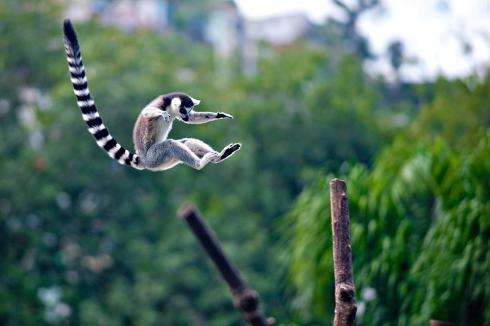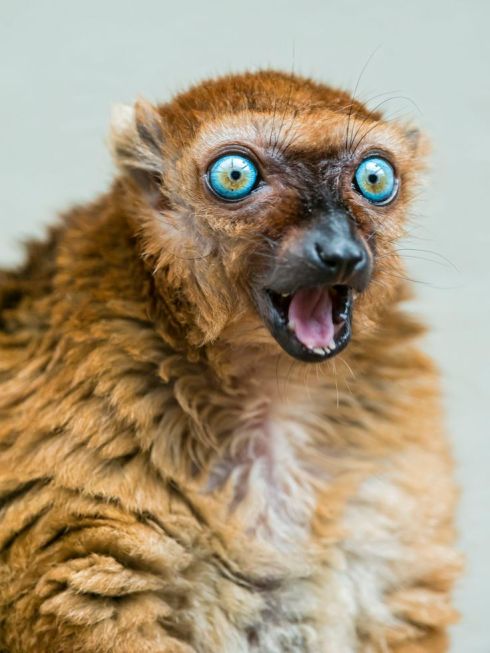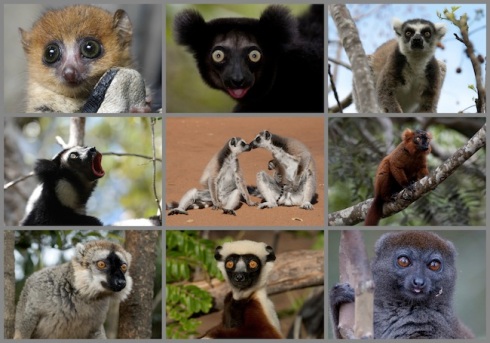You are currently browsing the tag archive for the ‘lemurs’ tag.
It is leap day! Every four years the niceties of the calendar give us this extra day. In the past, leap day has caused me to reflect about history, the calendar, and the ineluctable nature of time in general, but this year I am going a different direction. Instead of concentrating on the calendar aspect of the day, we will concentrate instead on “leaping.” And from there it is a short cognitive leap to the microcontinent of Madagascar where we find the masters of leaping, the lemurs.

Ring-tailed Lemur jumping (Lemur Catta) photo by Luc V. de Zeeuw
Lemurs are strepsirrhine (wet-nosed) primates endemic to the island of Madagascar. They are ancestral primates—the monkeys, apes, and hominids evolved from them (though of course these branches diverged in the Eocene and the lemurs have been evolving in their own directions for 50 million years). In fact, let me say that last sentence differently and better: monkeys (and apes and people) descended from a very lemur-like ancestor.

There are nearly 100 species of lemurs and they have spread through all sorts of evolutionary niches in Madagascar. It is hypothesized that they reached the island micro-continent by rafting there on masses of floating wood and vegetation. On Madagascar they were free to evolve in their own direction, as other primates back in the ultracompetitive African homeland went down different pathways. When humankind finally reached Madagascar 2000 years ago (from Indonesia!) there were even more strange lemurs, including some as large as gorillas, but the violent humans quickly snuffed them out (and indeed we are rapidly eating the remaining smaller lemurs out of house and home as well (or just eating them outright).

Female Sclaters lemur with open mouth (photo by “Tambako the Jaguar”)
Lemurs live in many habitats and specialize in many lifestyles. They are diurnal or nocturnal or crepuscular. They are fructivores, or herbivores, or insectivores. Some are omnivorous. With many different lifestyles come different habitats, but lemurs, like most other primates tend to be arboreal. While some lemurs imitate lorises and sloths and move with deliberate glacial slowness, the majority of lemurs have a different and far showier way of getting around—they leap from tree to tree like acrobats.

Perhaps I should say acrobats are like lemurs. Not only were the latter here first, but they are also capable of thrilling flights that would cause the most air-worthy flying Wallenda to fall down dead (literally). Using their long powerful back legs, lemurs hurl themselves into the air and then flatten out. They can thus leap up to 10 m (33 feet). And this is not an isolated leap. They can leap again and again and again…thus springing through whole jungles in a series of breathtaking bounds. The real masters of leaping—the ring-tailed lemur and Verreaux’s sifaka, hardly seem suited for any other sort of locomotion. When Verreaux’s sifaka is stranded in a tree island and is forced to cross open ground the poor creature looks quite ludicrous (see the gif below). It holds its arms above its head and leaps plaintively and swiftly across the hated land. But Verreaux’s sifaka looks utterly at home in its preferred habitat—hurling itself between spiny trees covered with razor sharp needles.

The more I read about lemurs, the more I realize I will have to come back and write more about them. It may be four years before the next leap day, but we will be back to lemurs before then!

